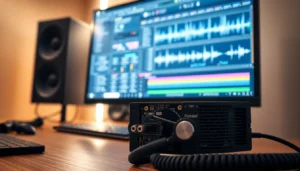Diving deep into the world of subsea technology is like exploring a hidden treasure chest—full of innovation, mystery, and the occasional octopus. As industries push the boundaries of what’s possible beneath the waves, staying updated on the latest advancements is crucial. From underwater drones that make James Bond look like an amateur to groundbreaking sensors that could teach fish a thing or two about communication, the subsea realm is buzzing with excitement.
Table of Contents
ToggleOverview of Subsea Technology News
Subsea technology continues to evolve rapidly, showcasing significant advancements that capture attention. Knowledge of these developments is crucial for professionals in various fields.
Importance of Staying Updated
Staying informed about subsea technology fosters better decision-making for companies and stakeholders. Engaging with current news mitigates risks associated with outdated processes. Organizations that track these advancements maintain a competitive edge in the market. Experts emphasize the value of timely information for strategic planning and resource allocation. Continuous learning ensures adaptability to changing environmental conditions and industry standards.
Key Areas of Development
Several key areas reflect substantial growth and innovation in subsea technology. Underwater drones, for example, enhance exploration and monitoring capabilities. Advanced sensors play a pivotal role in improving data accuracy and communication in marine environments. ROVs (remotely operated vehicles) are crucial for inspections and maintenance tasks. Artificial intelligence applications streamline data analysis and operational efficiency, showcasing a trend toward automation. Renewable energy solutions, including underwater turbines and wave energy converters, demonstrate the industry’s commitment to sustainability.
Recent Innovations in Subsea Technology
Recent advancements in subsea technology highlight the field’s dynamic nature. Innovations like autonomous underwater vehicles and enhanced sensor systems drive efficiency and sustainability across marine environments.
Autonomous Underwater Vehicles (AUVs)
AUVs represent a significant leap forward in subsea exploration. Equipped with advanced navigation tools, these vehicles conduct surveys with precision, reducing human intervention. Their application ranges from environmental monitoring to underwater archaeology, showcasing versatility. Companies such as Ocean Infinity utilize AUVs for deep-sea mapping, contributing to better resource management. As technology continues to evolve, AUVs enhance operational capabilities while minimizing environmental impacts.
Subsea Sensors and Monitoring Systems
Subsea sensors play a critical role in monitoring marine conditions. These devices collect data on temperature, pressure, and chemical composition in real-time. Enhanced accuracy improves decision-making for industries like oil and gas, fisheries, and environmental science. Notably, companies such as Kongsberg have developed sensors that communicate effectively, providing vital information to operators. As monitoring systems advance, they strengthen the ability to detect changes and protect ecosystems.
Major Companies in Subsea Technology
Several companies shape subsea technology, driving innovations across the industry. These organizations contribute significantly to advancements in underwater exploration, monitoring, and energy solutions.
Industry Leaders and Their Contributions
Companies such as Ocean Infinity and Kongsberg set benchmarks in subsea technology. Ocean Infinity excels in using autonomous underwater vehicles for deep-sea mapping, enhancing resource management. Kongsberg leads in developing high-accuracy sensors, enabling real-time data communication crucial for oil and gas, fisheries, and environmental science sectors. Such contributions streamline operations and improve decision-making capabilities. Major firms also invest in renewable energy solutions, integrating underwater turbines and wave energy converters that underscore a commitment to sustainability.
Emerging Startups to Watch
Several startups show promise in subsea technology. Notably, DeepOcean focuses on integrated solutions for offshore projects, concentrating on subsea power cable installation and maintenance, while Kinetica’s work on innovative AUVs aims to enhance environmental monitoring. Another notable player, H2O Technologies, develops smart sensors for underwater applications, enabling real-time data analysis. These emerging companies adopt cutting-edge technology to challenge established players, promoting a more sustainable and efficient subsea landscape as they innovate.
Challenges Facing the Subsea Technology Sector
Subsea technology encounters several challenges that impact its growth and effectiveness.
Environmental Concerns
Environmental sustainability remains a pressing issue. Subsea operations can disrupt marine ecosystems and adversely affect wildlife, leading to a call for more responsible practices. Regulations and compliance create additional hurdles for companies aiming to minimize their environmental footprints. Developing technologies with lower environmental impacts is essential in this landscape. Companies actively focus on innovations that enhance eco-friendliness while maintaining operational effectiveness.
Technical and Financial Barriers
Technical barriers hinder the full integration of subsea technology. High costs associated with research, development, and deployment often deter investment. Equipment reliability and insufficient infrastructure also contribute to these challenges. Financial constraints limit the ability of smaller companies and startups to compete against established players. Securing funding for advanced subsea projects proves difficult when potential returns are uncertain. As a result, collaboration between industry players may drive shared solutions, promoting innovation and economic viability.
Future Trends in Subsea Technology
Subsea technology is evolving rapidly, shaped by significant trends in digital integration and sustainability.
Digital Transformation and IoT Integration
Digital transformation drives efficiency in subsea operations. Integrating Internet of Things (IoT) devices enhances real-time data collection and analysis. Companies leverage connected sensors to monitor marine environments continuously. This connectivity allows for improved decision-making and operational oversight. For instance, AUVs equipped with IoT technology gather data without human intervention, streamlining workflows. Enhanced data analytics capabilities also help identify emerging patterns and predict maintenance needs. The convergence of data and technology contributes to smarter subsea operations and minimizes risks associated with human error. Ultimately, embracing digital tools enhances the industry’s responsiveness to changes.
Sustainable Practices and Green Technologies
Sustainable practices take center stage in subsea technology development. Companies prioritize eco-friendly solutions to reduce environmental impact. For example, underwater turbines and wave energy converters capitalize on renewable resources, lowering carbon footprints. Marine biodiversity protection drives innovation in non-invasive monitoring techniques. As industries strive for sustainability, responsible practices become must-haves. Partnerships among key players foster the development of technologies that mitigate environmental disruption. These collaborations also aim to set new standards for eco-conscious practices in subsea operations. Emphasizing sustainability aligns industry advancements with global environmental goals, leading to a greener future.
The subsea technology landscape is rapidly transforming with innovations that promise to enhance efficiency and sustainability. As companies like Ocean Infinity and Kongsberg lead the charge, emerging startups are also making significant strides. The focus on environmental responsibility is reshaping operational practices and pushing the industry toward greener solutions.
Staying informed about these advancements is vital for professionals aiming to navigate the complexities of this evolving field. Embracing new technologies and fostering collaborations will be essential in overcoming challenges and driving the subsea sector forward. The future holds exciting possibilities that could redefine how industries interact with our oceans.



